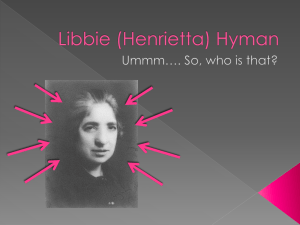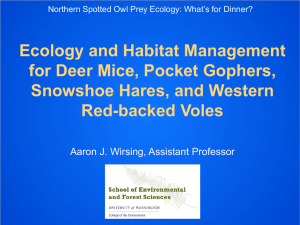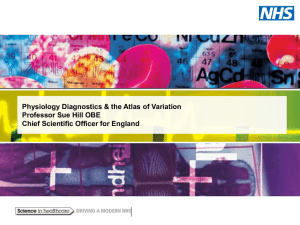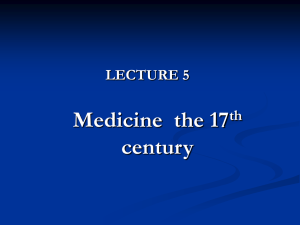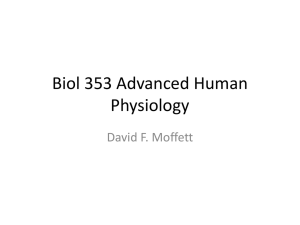Zool 4409/5409 Comparative Animal Physiology
advertisement
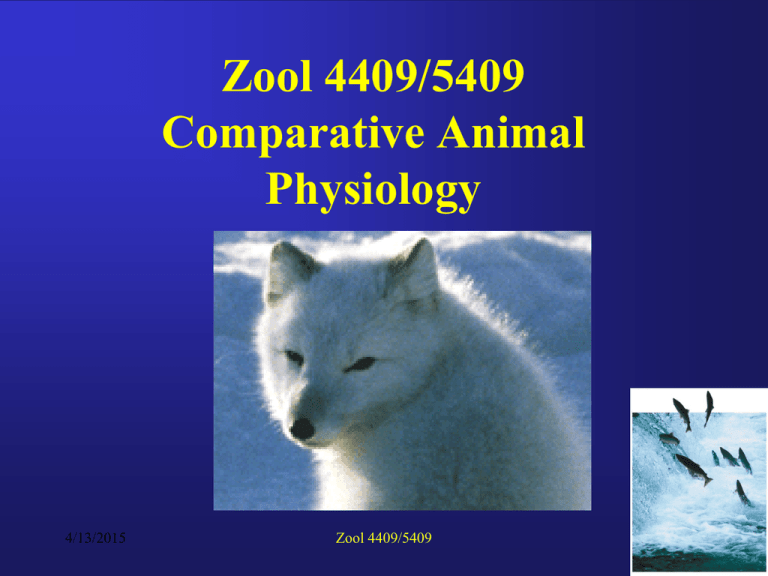
Zool 4409/5409 Comparative Animal Physiology 4/13/2015 Zool 4409/5409 4/13/2015 Zool 4409/5409 Introduction • Introduction • Basic Principles of Physiology 4/13/2015 Zool 4409/5409 Introduction • Animal physiology is an attempt to answer the question- How do animals work? • Requires a background in chemistry, physics, anatomy and zoology – physiological principles follow basic laws of physics and chemistry • Principally a science of the last 3 centuries 4/13/2015 Zool 4409/5409 Hemodynamics Q = blood flow rate (mL/sec) P= pressure difference between ends of vessels P = Q R = resistance R P2 P1 4/13/2015 Zool 4409/5409 Georg Simon Ohm OHM'S LAW • V=IxR • V/R = I • I, current; R, resistance; V, voltage Introduction (con’t) I. Search for generalizations – Can we study the heart of a frog and make predictions about how the human heart works? – Can we study nerve function in an invertebrate and learn how our nervous system works? 4/13/2015 Zool 4409/5409 Squid axons are important to physiologists, and to the squid 4/13/2015 Zool 4409/5409 YES! 4/13/2015 Zool 4409/5409 • At the cellular level, there are many similarities in function among all animals • Animals cells use ion movement across the cell membrane to maintain water balance. • Plant cells use a thick cell wall in plants. 4/13/2015 Zool 4409/5409 At the organ system level, many similarities amongst the vertebrates • Frog skeletal muscle is great for lab study. • Can be maintained at low temps. • Low oxygen demands. • Most of what we know about how human muscle works is based on frog studies. 4/13/2015 Zool 4409/5409 • All animals are faced with the same sorts of physiological problems – obtain and digest food – supply oxygen to tissues – get rid of carbon dioxide and other wastes – maintain body fluids – study how a system works in a simple model and learn how this works in humans 4/13/2015 Zool 4409/5409 Introduction (con’t) II. Search for oddities (“gee-whiz” physiology) – How do fish survive in the seas off antarctica? – How do some animals such as turtles survive after their body fluids have frozen? 4/13/2015 Zool 4409/5409 Fish around Antarctica spend their entire lives at body temperatures near –1.9°C 4/13/2015 Zool 4409/5409 McMurdo Sound, Antarctica 4/13/2015 Trematomus bernacchii Zool 4409/5409 Antifreeze glycoproteins 4/13/2015 Zool 4409/5409 Introduction (con’t) Knowledge of how animals adapt to extreme environmental problems may be useful for learning about human performance in extreme situations; eg. Space, underseas, etc. 4/13/2015 Zool 4409/5409 4/13/2015 Zool 4409/5409 Bar-headed GooseFly at 30,000 feet Unique hemoglobin III. Knowledge for Knowledge’s sake • basic science is required for all advances and applications in science • emphasis on “product-oriented” science will result in fewer new discoveries. 4/13/2015 Zool 4409/5409 Introduction (con’t) IV. Physiology is the cornerstone of human medicine. • Good physicians must have a solid understanding of how the body functions normally in order to diagnose disease 4/13/2015 Zool 4409/5409 Basic Principles of Physiology I. Form follows function over time (geologic time), form evolves with function 4/13/2015 Zool 4409/5409 4/13/2015 Zool 4409/5409 4/13/2015 Zool 4409/5409 4/13/2015 Zool 4409/5409 Basic Principles of Physiology II. Homeostasis • Ability to regulate internal environment within narrow limits Homeostasis = balance • Claude Bernard (maintenance of the internal milieu, late 1800s) • Walter Cannon (coined the term homeostasis, early 1900s). Basic Principles of Physiology II. Homeostasis (con’t) • Maintained by multiple control systems – eg. Blood pressure is regulated by both short-term (seconds) and long-term (min, hr, days, wks) 4/13/2015 Zool 4409/5409 Control systems involved in blood pressure regulation Short term Long term Baroreceptor reflex (sec) Renal filtration Angiotensin (hormone, minhr) Aldosterone (hormone, minhr,days) 4/13/2015 Zool 4409/5409 4/13/2015 Zool 4409/5409 Disruption of homeostasis- stress Stressor 4/13/2015 Zool 4409/5409 4/13/2015 Zool 4409/5409 4/13/2015 Zool 4409/5409 Figure 1.6 Mixed conformity and regulation in a single species 4/13/2015 Zool 4409/5409 Basic Principles of Physiology III. Regulatory systems • Nervous system DETECT INTEGRATE RESPOND storage integrate learning retrieval 4/13/2015 Zool 4409/5409 Basic Principles of Physiology III. Regulatory systems (con’t) • Endocrine system stimulus endocrine cell hormone RESPONSE 4/13/2015 Zool 4409/5409 blood Target Neuroendocrine Integration Endocrine system Nervous system Neuroendocrine system Endocrine organs cannot detect environmental changes on their own- they require input from nervous system 4/13/2015 Zool 4409/5409 Basic Principles of Physiology IV. Feedback control • Negative feedback – reduces the difference between the output and setpoint. eg. thermostat 4/13/2015 Zool 4409/5409 • Positive feedback – increases difference between outpoint and setpoint 4/13/2015 Zool 4409/5409 4/13/2015 Zool 4409/5409 4/13/2015 Zool 4409/5409 Feedback Control of Body Temperature HBC Higher brain center Set point = 98.6o F - integration THERMORECEPTORS hypothalamus coordination effector Response hypothalamus eg., muscle Basic Principles of Physiology V. Critical thinking and the scientific method A. Inductive reasoning B. Hypothesis C. Deductive reasoning D. Testing hypothesis 4/13/2015 Zool 4409/5409 Basic Principles of Physiology A. Inductive reasoning-Francis Bacon, 1620 • Collecting information in an unbiased way. • In 1620 Bacon published Novum Organum (Or True Directions Concerning the Interpretation of Nature) Without inductive reasoning: Example of bad science: • >400 years ago, Bishop Usher concluded that the earth began on October 9th, 4004 BC, 9:30 AM by counting the number of “begats”. 4/13/2015 Zool 4409/5409 TRUE DIRECTIONS CONCERNING THE INTERPRETATION OF NATURE Francis Bacon 1620 • “The formation of ideas and axioms by true induction is no doubt the proper remedy to be applied for the keeping off and clearing away of idols. To point them out, however, is of great use. “ The Four Idols of Bacon that Prevent Accurate Interpretations of Nature • The Idols of the Tribe-erroneous preconceived ideas common to one’s tribe or community The Four Idols of Bacon that Prevent Accurate Interpretations of Nature • The Idols of the Cave- erroneous beliefs of one’s mind; individuals tend to favor their own ideas 4/13/2015 Zool 4409/5409 The Four Idols of Bacon that Prevent Accurate Interpretations of Nature • The Idols of the Marketplaceeveryday language is not sufficient for describing scientific ideas 4/13/2015 Zool 4409/5409 The Four Idols of Bacon that Prevent Accurate Interpretations of Nature • The Idols of the Theatreadherence to theological and philosophical modes of thought where truth is deduced from what is assumed to be true. Hypothesis Follows Observation B. A hypothesis is a testable prediction, falsifiable. Ie., based on data, we can either accept or reject the hypothesis. 4/13/2015 Zool 4409/5409 Falsifiable hypothesis The adrenal gland is involved in regulating blood sugar. – Based on data we accept or reject hypothesis. Non-falsifiable hypothesis God created the earth in 7 days. This hypothesis can’t be falsified. 4/13/2015 Zool 4409/5409 NOTE: Nothing is ever proven or disproven in science. Scientific theories are accepted or rejected based on collection of evidence. 4/13/2015 Zool 4409/5409 Basic Principles of Physiology C. Deduction– if adrenal gland is involved in regulating blood sugar, then removing adrenal should alter blood sugar. D. Testing hypothesis- state of the art technology. 4/13/2015 Zool 4409/5409 Theory of evolution • • • • Populations increase variability within species resources are limited those best fit to utilize resources reproduce and survive - • Descent with modification! Industrial melanism in Biston betularia (see H.B.D. Kettelwell. 1973. Industrial Melanism. Oxford Univ. Press, Oxford, U.K.) •Two forms of the pepper moth in Britain, light form and melanistic form •Single gene difference leads to more melanin pigment synthesis •In the last 150 years, switch from fewer to more melanistic forms Basic Principles of Physiology geoscience paleontology archeology Theory of Evolution (Descent with modification) biochemistry 4/13/2015 molecular biology Zool 4409/5409 OTHER THEORIES RELATED TO PHYSIOLOGY • CELL THEORY • THEORY OF GENETIC INHERITANCE 4/13/2015 Zool 4409/5409
